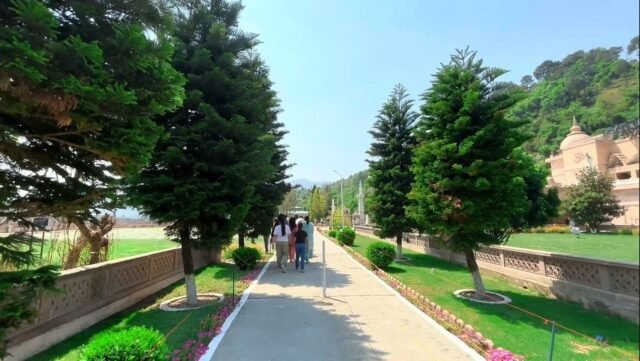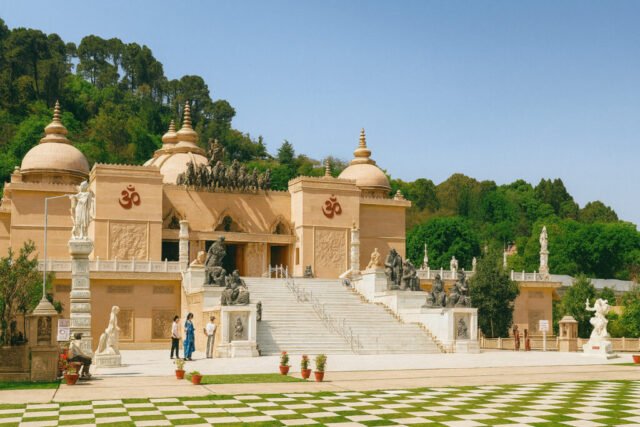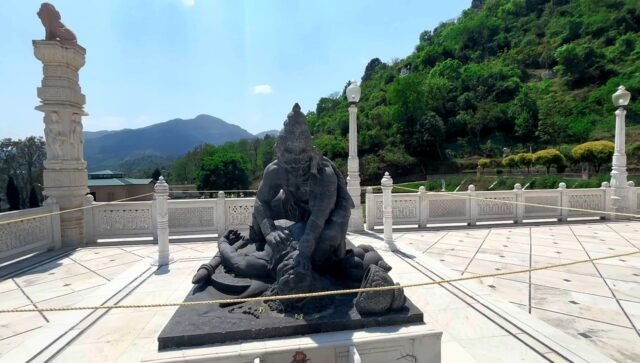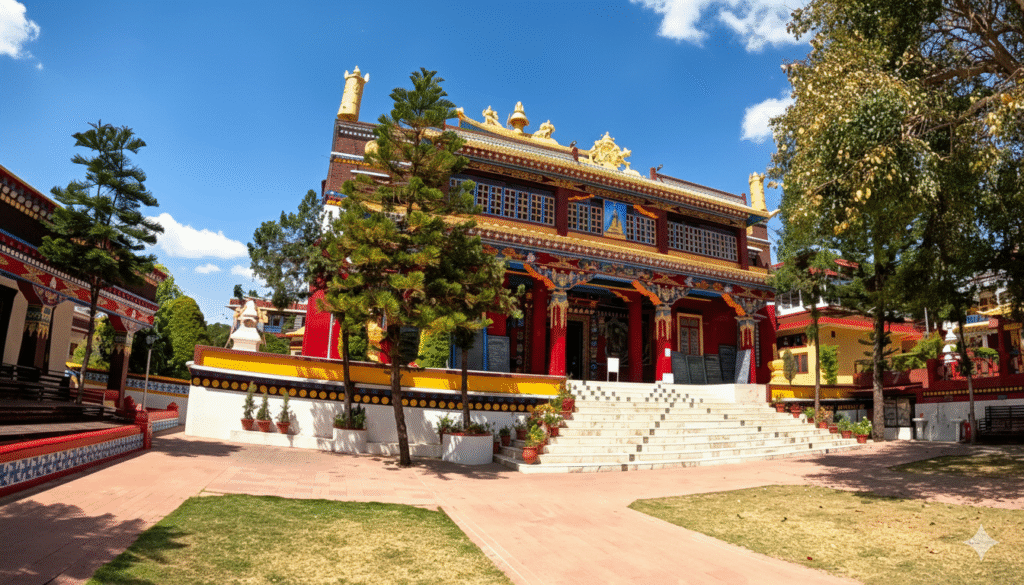1) Introduction
In the of Solan district, Himachal Pradesh, lies the Mohan Shakti Heritage Park—a place where spirituality, Indian culture, and natural beauty meet in a magnificent blend. The park is situated on a hillside; so the moment you cross the entry gate, manicured gardens, the grand Shri Krishna Mandir, and mythological sculptures welcome you. The gentle ringing of temple bells, the earthy scent of the mountains, and the resonance of devotional hymns together weave a truly divine atmosphere.
This campus is not just a temple complex but a living cultural space where Indian epics—Ramayana and Mahabharata—are transformed into visual storytelling through sculptures, murals, and installations. For families, this place is the perfect blend of a picnic spot and a spiritual retreat; for students and researchers, the heritage museum is an educational goldmine. If you are looking for Solan temples or spiritual places near Chandigarh/Shimla, Mohan Shakti Heritage Park deserves to be at the top of your itinerary.
In this blog, you’ll find everything in one place—Mohan Heritage Park’s history & significance, architecture, things to see, how to reach, best time to visit, nearby attractions, and detailed FAQs—so your plan can be both practical and memorable.
22) History & Significance of Mohan Heritage Park
2.1 Establishment and Purpose
The creation of Mohan Shakti Heritage Park was inspired and overseen by the Mohan Shakti Trust. The core vision of the Trust was: “To preserve and promote Indian heritage, spiritual teachings, and cultural values.” The park was inaugurated around 2002 and gradually became one of Solan’s largest spiritual-cum-tourism hubs. Visitors come here not only for darshan but also for culture walks and heritage learning.
2.2 Importance of Shri Krishna Mandir
At the heart of the campus stands the Grand Shri Krishna Mandir, celebrated for its distinctive fusion architecture. A blend of North Indian shikhara style and South Indian mandap symmetry makes it an architectural marvel. Marble carvings, gilded detailing, and mythological themes make the temple a perfect example of divinity combined with craftsmanship.
A standout feature is the seven-horse chariot atop the temple, representing strength, vitality, and cosmic harmony. Within the temple premises, you will also find idols of Lord Vishnu, Shiva, Maa Durga, Shubh–Laabh, and countless other deities. The temple space is designed as a pan-Indian spiritual hub where devotees can connect with gods and goddesses from multiple traditions.
2.3 Cultural Storytelling Through Sculptures
The park showcases life-sized sculptures and murals that vividly depict the Gita’s teachings, Krishna-Leela, Ram-Sita swayamvar, the exile, the burning of Lanka, and the Kurukshetra war. These are not just photo spots, but teaching tools—through which children and youth connect with Indian mythology.
Adding to the uniqueness, the park also houses statues of deities that are rarely worshipped or even known to many devotees. You may come across forms and figures that make you wonder about the diversity of Sanatan Dharma. Inside the sanctum, a magnificent idol of Maa Durga is installed, where daily puja and rituals are performed with devotion.
In the heritage museum, rare artifacts, miniature paintings, temple art references, and scriptural displays can be found—turning the park into an open-air cultural classroom.
2.4 Community & Education
The philosophy of the Mohan Heritage Park is: “Devotion with learning.” Student visits, cultural workshops, devotional music programs, and festive celebrations are regularly organized here. On Janmashtami, special decorations and cultural shows transform the campus into a celebration of Bhakti and Indian heritage. In this way, Mohan Shakti Heritage Park combines faith with knowledge—and that is its true significance.
3) Architectural Highlights
Shri Krishna Mandir: Multi-tiered shikhara, marble inlay work, carved pillars, mythological motifs, and the striking seven-horse chariot at the top. At night, the structure looks even more regal under soft lighting.

Mythological Sculpture Courts: Epic tableaux across the campus—Bhishma on the bed of arrows, Arjuna–Krishna chariot, Hanuman carrying Sanjivani—make you feel like you are walking through a living museum.
Heritage Museum: Curated galleries with text panels, replicas, and regional art. Discover the essentials of Indian temple iconography through these displays.
Exquisite statues portray the Solah Shringaar—the sixteen divine adornments—alongside Shubh–Laabh and rare deities from the vast pantheon of gods and goddesses.
Landscaped Gardens & Water Features: Wide lawns, lotus ponds, fountains, and peaceful walkways make it ideal for meditation and photography.
Panoramic Vantage Points: Due to its hillside placement, the park offers sweeping views of Solan valley—especially magical during sunrise and golden hour.
4) Things to See at Mohan Shakti Heritage Park
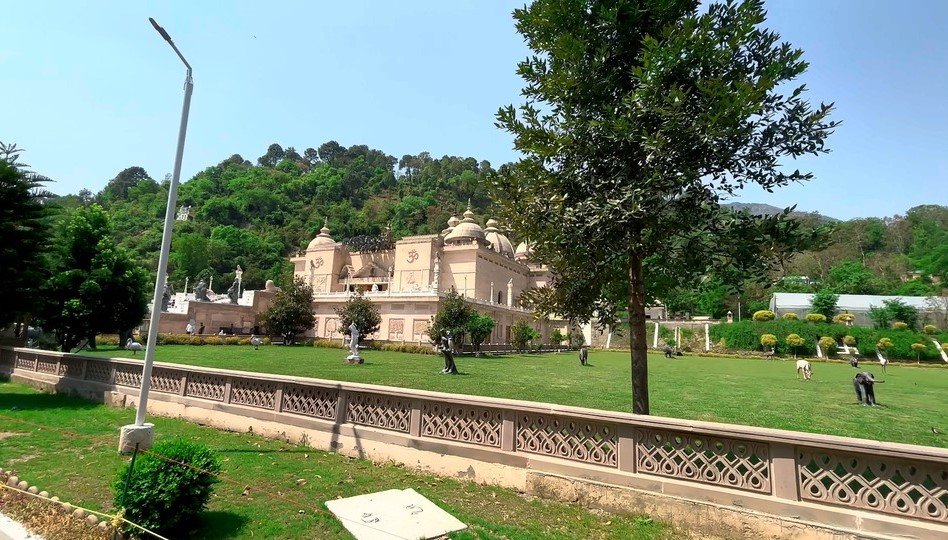
4.1 Grand Shri Krishna Mandir
The temple darshan establishes the spiritual rhythm of the entire visit. The inner sanctum radiates divine stillness, the outer hall displays intricate carvings, and the courtyard resounds with the sound of the aarti bells—even standing here for three minutes brings peace to the mind. Architecture lovers will enjoy the symmetry, cornice detailing, trellis patterns, and of course, the seven-horse chariot on top.
4.2 Mythological Murals & Life-Sized Sculptures
The sculpture courts unfold the moment you step in—Krishna and Arjuna on the chariot (Bhagavad Gita), the clash of Ram and Ravan, Hanuman soaring through the skies, Shiva–Parvati depictions, Dashavatar scenes, and more. Each tableau comes with informative plaques, helping you understand the context, click photos, and recap mythology.
4.3 Heritage Museum
The museum is enriched with miniature paintings, temple-inspired wood and stone carvings, and replicas of ancient scriptures. Children and students can engage with guided reading panels, while researchers may find quiet corners for study and note-taking.
4.4 Gardens, Fountains & Meditation Spots
Walking through the landscaped gardens is a therapeutic experience. Benches with hill views, the sound of fountains, and distant temple bells create a natural detox for the mind. The gentle walking trails are a favorite among couples and families.
4.5 Hilltop Views & Photography Frames
From multiple vantage points in the park, you get epic frames of Solan valley and the temple silhouette. During sunrise and late afternoon, the golden light bathes the architecture, creating picture-perfect moments for reels and thumbnails.
4.6 Cultural Events & Festive Decor
During Janmashtami, Gita Jayanti, and other occasions, devotional music, processions, and decorative lighting bring the campus alive. For cultural photography lovers, these dates offer the perfect blend of heritage and festivity.
⚠️ Travel Tip: The last few kilometers towards Mohan Shakti Heritage Park are on a single road. If you are driving yourself, please be careful and drive slowly.
5) How to Reach Mohan Shakti Heritage Park
📍 Location: Shilly Road, Solan (HP) — approx. 17 km from Solan city center.
5.1 By Road (Self-Drive / Taxi)
From Solan: 20–30 minutes from city/bus stand. Local taxis are easily available.
From Chandigarh (≈86 km / 2–2.5 hrs): NH-5 → Dharampur → Solan. Once you reach the city, follow Shilly Road signboards. For family trips, a cab is the most comfortable option.
From Shimla (≈40 km / 1.5 hrs): Take NH-5 down towards Solan, then turn onto Shilly Road. The scenery is superb, but during monsoon, check for landslip alerts.
From Delhi (≈315 km / 6–7 hrs): NH-44 → NH-5; best to start in the morning, reach Solan around lunchtime, and explore the park in the evening.
5.2 By Train (Kalka–Shimla Heritage Line)
The nearest station is Solan Railway Station. For toy-train lovers, this route itself is an experience. From the station, it’s a 12 km taxi ride; the road is in good condition.
5.3 By Air
The nearest major airport is Chandigarh. From there, a prepaid cab will take you via Chandigarh → Solan → Shilly in about 2–2.5 hours. For group travel, this option is also cost-effective.
5.4 Parking, Accessibility & Tips
- Parking space is available outside the campus.
- Walkways are largely wheelchair-friendly, though some slopes exist—having assistance is helpful.
- Carry anti-slip footwear during the monsoon.
- On weekends and festivals, crowds increase—arriving early ensures a peaceful exploration.
🚗 Travel Note: The last few kilometers towards Mohan Shakti Heritage Park are on a single road. If you are driving yourself, please be careful and drive slowly.
6) Best Time to Visit Mohan Shakti Heritage Park
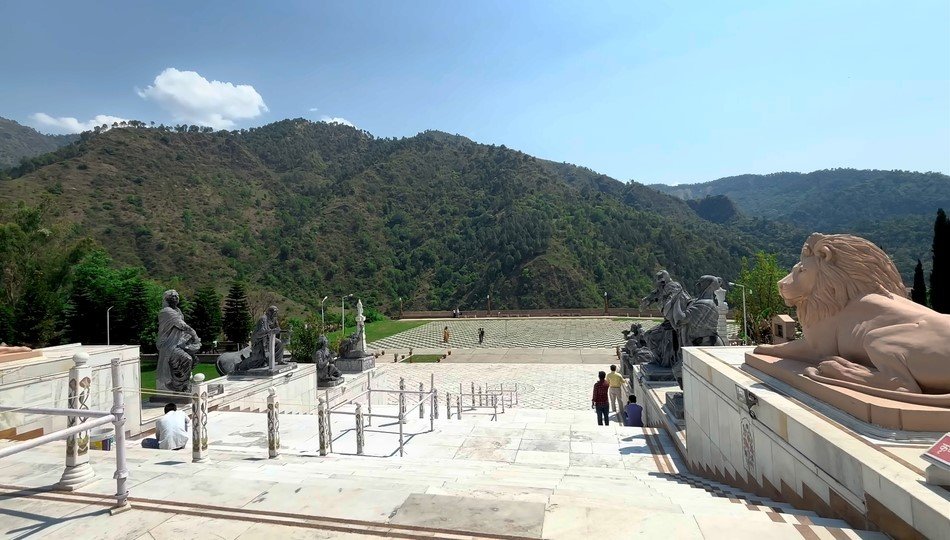
February–April (Spring): Blooming gardens and clear skies; perfect for heritage walks and portraits.
May–June (Summer): Pleasant mountain breeze; an ideal escape from Chandigarh/Delhi heat. Great for family day trips.
July–August (Monsoon): Greenery at its peak with dramatic cloud play—fantastic for photography. Just carry rain gear and grippy shoes.
September–November (Autumn): Crystal-clear visibility, golden light, and the charm of festival season.
December–January (Winter): Cold winds, crisp frames, light crowds; after morning darshan, sitting in the sunlit lawns feels soothing.
✨ Festive Highlight: During Janmashtami, the campus glows with devotional music, decorations, and cultural programs—making it the best time to visit for a spiritual vibe.
7) Visitor Information
Entry Fee: Free (donations welcome).
Timings: 8:00 AM – 6:00 PM; extended hours on festivals.
Facilities: Drinking water, clean washrooms, seating benches, and basic snack options near the campus.
Photography: Allowed, but avoid clicking too close to idols inside the temple. Please maintain respect and avoid tripods/stage setups during crowds.
Dress Code: Decent/traditional clothing is preferred; silence is expected in sanctum areas.
Time Needed: Temple visit + museum + a slow walk with photos takes 2–3 hours.
Cleanliness: Keep the campus litter-free; use bins provided.
Good News: On Sundays, devotees can enjoy the Bhandara (community meal) organized at the park.
8) Our Experience At Mohan Heritage Park
Crossing the entry arch of the Mohan Shakti Heritage Park Solan, we instantly felt a royal-meets-devotional vibe. Standing in front of the Shri Krishna Temple inside the campus, the intricate marble carvings made us automatically switch on our camera. When we first visited the Mohan Shakti Heritage Park in Himachal Pradesh, we were surprised that such a grand spiritual site existed in Solan—and here we were, experiencing it again.
Walking through the mythological sculpture courts, every tableau gave us a childhood mythology recap—especially the Krishna-Arjuna chariot and Hanuman in flight. After spending 20–25 minutes in the heritage museum at Mohan Shakti Park, we stepped into the lawns, and alongside flowed the Ashwani Khad River. The cool mountain breeze, the distant echo of the aarti, and the serene atmosphere made the entire moment meditative. We can even practice meditation here—it’s an incredibly silent place. Please maintain that silence when you visit.
For families, the Mohan Shakti Heritage Park Solan Himachal Pradesh is one of the best options—it’s bound to be a memorable trip. For content creators, it’s a paradise with reels, thumbnails, and B-roll opportunities. And for everyone, the safe, clean, and peaceful environment makes it one of the top Solan tourist attractions.
9) Nearby Attractions From Mohan Shakti Heritage Park
Jatoli Shiv Mandir (~24 km from Solan / ~20–25 mins from Park):
Famous for its 111-feet shikhara, many consider it the world’s tallest Shiva temple. With its sacred cave and Jal-Kund, it offers a deeply spiritual vibe. At golden hour, the temple’s silhouette looks breathtaking. Mohan Shakti and Jatoli are best covered on the same day circuit.
Shoolini Mata Temple (~14 km, Solan City):
Dedicated to Solan’s kuldevi, this ancient temple is in the city center. The Shoolini Mela (June) is famous for cultural parades, folk music, and bazaars. Evening aarti followed by a short Mall Road walk is a perfect combo.
Karol Tibba Trek (Trailhead ~10–12 km):
A medium-difficulty trek, known for panoramic views and the Karol Cave (linked with Pandavas). Safest after monsoon with lush greenery. Carry water and light snacks; sunrise starts are best.
Kasauli (~45 km / 50–70 mins):
A charming colonial hill station—visit Christ Church, Gilbert Trail, Sunset Point, and cozy cafes. A perfect relaxed half-day trip after Mohan Shakti.
Riva Waterfall (~1-2 km):
Just 1 km from Mohan Shakti Heritage Park, a short 2–3 minute walk will lead you to a beautiful natural spot surrounded by greenery — the refreshing Riva Waterfall. A hidden gem perfect for peaceful moments in nature.
📍 Mohan Shakti Heritage Park – Location, Photos & Videos
🎬 YouTube – [KKSB VLOGS]
An exclusive video tour of Mohan Shakti Heritage Park will be uploaded on our YouTube channel given below the blog. You’ll get complete details of the park, sightseeing spots, and visitor tips. Don’t miss it!
📲 Instagram – [offcial_kksb]
Reels & latest photo updates of the park will be shared on our Instagram handle. Follow us for instant highlights and short clips.
🗺️ Exact Location:
At the end of this blog, you’ll find an embedded Google Map. From there, you can check the direct directions & accurate location to easily plan your visit.
Mohan Shakti Heritage Park Photos
Mohan Shakti Heritage Park Vlog
Mohan Shakti Heritage Park Location
FAQs About Mohan Shakti Heritage Park
Where is Mohan Shakti Heritage Park located and how to reach?
It is in Shilly village, Solan (HP), approx. 17 km from Solan city. From Solan, taxis/auto take 20–30 mins. From Chandigarh via NH-5, 2–2.5 hrs; from Shimla, ~1.5 hrs. Google Maps pin is accurate.
What are the main attractions and how much time is needed?
The highlights are the Grand Shri Krishna Mandir, mythological sculptures, heritage museum, and landscaped gardens. Ideally keep 2–3 hours; on festival days, more time is needed.
What is the best time to visit?
For weather and photography, Feb–Apr and Sep–Nov are best. During Janmashtami, the park has special decorations and programs—perfect for the spiritual vibe. Monsoon offers lush greenery.
Entry fee, timings, and facilities?
Entry is free; timings are 8 AM – 6 PM (extended during festivals). Facilities include drinking water, clean washrooms, benches, and basic snacks. Please maintain temple decorum.
Is photography allowed? Best photo spots?
Yes, photography is allowed respectfully. Best frames: temple façade, sculpture courts, lotus pond, and hilltop vantage points. Architecture glows beautifully at golden hour.
Is it friendly for families and senior citizens? Wheelchair access?
Yes, the campus has parking and mostly wheelchair-friendly paths. Some slopes exist—an assistant is helpful. Benches and shaded lawns make it comfortable for elders.
Which nearby attractions can be covered?
Close circuit includes Jatoli Shiv Mandir, Shoolini Mata Temple, Karol Tibba Trek, Kasauli, and Solan Mall Road. Jatoli + Mohan Shakti + Bon Monastery can easily be covered in one day.
Are there food options inside?
Tea/snack stalls are available near the campus; Solan city has many cafes and restaurants. On crowded weekends, carrying light snacks is better.
How good is it for group/school visits?
Excellent—because mythology here is presented through visual learning. The museum, sculptures, and gardens make student trips engaging. With prior coordination, guided visits are smooth.



